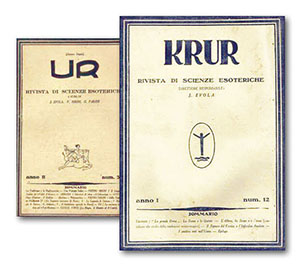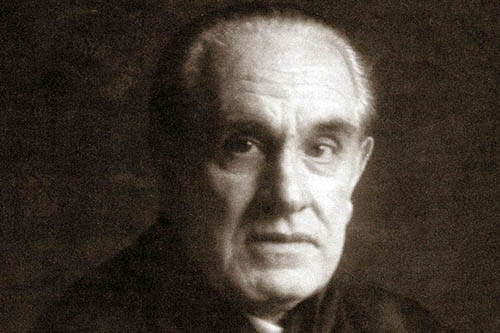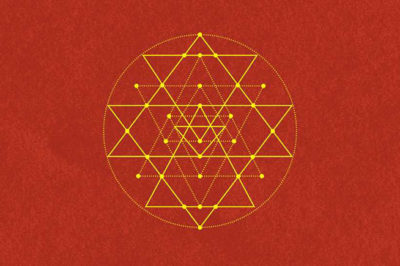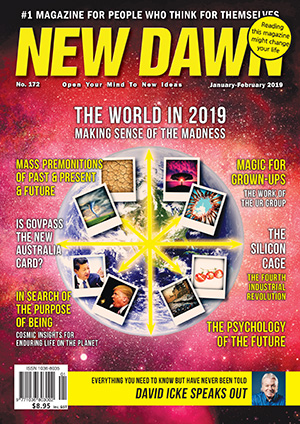From New Dawn 172 (Jan-Feb 2019)
In the consensus view, magic belongs (if at all) in Disney films and Harry Potter books, and adults who actually believe in it are stuck in infantile or medieval superstition. It does not help that the most famous magus of modern times, Aleister Crowley, was a sex maniac and a drug fiend.1 Nor does the later development of Chaos Magick inspire much hope, with its dark, postmodern metaphysic. To most sane people, whether or not they have a spiritual outlook, magic is best left alone.

This would also have been the attitude of the “Gruppo di UR,” a group of Italians led in the late 1920s by Julius Evola and Arturo Reghini.2 Their magic was not for the casual, the credulous, or those excited by the cool or the weird. It was for those dedicated to “magic as science of the I,”3 a concept that I will try to explain below. Although the group’s activities were private, involving only a handful of participants, they shared them with the world in a monthly journal, called first UR and then KRUR. The print-run, estimated at a thousand copies, suggests a surprising level of interest in Fascist-era Italy. In its three-year existence, UR/KRUR published 142 articles under 23 different pseudonyms, making it one of the twentieth century’s richest compilations of esoteric material and instruction.
English language readers had access to the UR Group’s work in 2001, with a translation of the first of the three volumes.4 I helped with its preparation and promised that if no one else could be found to translate the other two, I would do so after I retired. Eventually I had to keep my promise. The second volume will appear in February 2019, and the third, hopefully, before another eighteen years have gone by.

In his Introduction, Julius Evola states that the goal of this magic is knowledge of “metaphysical reality.”
Metaphysical reality exists and works in transcendent mode, in utter independence from the world of men. Nonetheless, he who is established in that mode and casts his glance downward can draw from it reference-points for a system of values and principles, which may confer earthly and temporal life with an order and a meaning that would otherwise be wholly lacking. (p.1)5
Those familiar with Evola will recognise in these few lines the core of his doctrine. It is a hard and chilly one for those preferring the comforts of religion and a warm embrace of humanity. This magic has nothing to do with them, or with the order and meaning that help them to get by in earthly life. It is anti-humanistic, antisocial, and utterly at odds with the modern world. But although Evola was at the centre of the UR enterprise, he was not so harsh in his choice of collaborators. Being “established in metaphysical reality” is a tall order, and none of them claimed more than temporary glimpses of it. What they did claim, though, is that it has existed, and left its traces in Tradition.
“Tradition,” as the word was used by Evola, René Guénon, and Ananda Coomaraswamy, meant the body of wisdom acquired or revealed in the distant past and handed down in the form of myths, symbols, rites, and to an extent religions.6 There was a time, they say, when humanity lived in concord with it, open to spiritual realities and in harmony with nature. But that was a Golden Age, and we are in the Age of Iron, the Kali Yuga.7 The magic of the UR Group is a lifeline for a few in this dark age who sense what has been lost and are determined to regain it.
The UR Group’s journals contained five different kinds of documents:
- Expositions of methods, disciplines, and techniques;
- Reports of initiatic experiences, historical and contemporary;
- Translations of traditional texts. The first volume included a Mithraic Ritual and excerpts from Neoplatonic, alchemical, and Buddhist writings; the second, songs of Milarepa and a complete translation of the Turba philosophorum, with commentaries.
- Traditional doctrines placed in context, to challenge modern views and attitudes;
- The study of various forms of Tradition over history, to show their continual validity in the human world.
The three volumes are not necessarily sequential because new contributors appear and the articles address different levels of commitment. One need not tread the magical path to appreciate the UR Group’s global approach to esotericism, which owed much to the Theosophical Society’s example of opening to the wisdom of the East. Esotericism apart, there is a refreshing contrast between their attitudes and the forced consensus of today.
Magic Guided by Science
When Evola edited the group’s papers for publication in book form, the title “Introduction to Magic as Science of the I” implied that this was not a belief system but a science. Nothing was to be taken on trust unless proved by personal experience – and even then, subjected to the test of Tradition. The latter acted as a control for evaluating modern movements such as spiritualism, psychical research, occultism, Theosophy, psychoanalysis, and Jung’s depth psychology. All of these failed the test of traditional authenticity and were dismissed as deviances only to be expected of a dark age. But unlike the Traditionalism of René Guénon and his followers, that of the UR Group paid no respect to exoteric religions. To the aspirant for their sort of magic, religions were simply irrelevant. To Reghini, especially, they were worse than that, for he was a staunch defender of pagan traditions against monotheism and the Christian hegemony.
A partial exception was made for Rudolf Steiner’s Anthroposophy. Several members of the UR Group were active in Steiner’s movement, and their contributions reflect this. But Evola, as editor, drew a firm line between Steiner’s techniques for obtaining “knowledge of higher worlds” and his Christocentric and reincarnational doctrines.
The scientific method is essentially amoral: that is why it is widely mistrusted today. The science of the UR Group followed the same principle, but with a crucial difference:
As an example, from the moral point of view one may say: “You mustn’t lie, because lying is bad, and telling the truth is good.” From the initiatic point of view one is simply aware that lying causes a sort of lesion and contradiction in the unity of the being, which is a condition contrary to that of an initiatic qualification. (p. 243)
The most dedicated members of the group formed “chains” for group work, numbering perhaps no more than five participants. They worked with guided imagery to build up psychic energy, and might “eventually be able to contact other chains, created on the same principles by other groups and in other places.” One wonders whether this has actually happened. Hans Thomas Hakl’s Foreword mentions that UR-type groups continue up to the present day, mostly in Italy and all in deliberate obscurity. Here are some of the principles:
In some kinds of chain the individuals are simply thrown together, and the polarity of masculine 0 and feminine Y necessary for operations is not reflected harmoniously in every member. Instead, they separate into the opposition of the fluid, passive mass formed by the majority = Y, and the active role of a leader = 0. But in the type of chain proposed here, every member must distinctly and firmly possess self-awareness, control, and mastery: thus both aspects of the Hermetic complementarity. Each must participate in the chain as an individual, as a distinct force. The chain formed by such individuals will become compact and positive in every way when, through repeated meetings, the various distinct elements become attuned and form a unity. (p. 42)
Beyond the Grave & the Great Liberation
These practices served an intention that went beyond one’s earthly life. In a commentary on the Tibetan Book of the Dead, Evola (writing as “Ea”) remarks:
One notes the special emphasis on qualities that need to be obtained in one’s lifetime, through suitable disciplines and control of one’s own mind; they are not only of use in this existence and for progress along the Way, but also beyond the grave, in the battle for one’s own destiny. (p. 137)
Experiences “beyond the grave” are beyond the reach of the empirical science that the UR Group preferred. Consequently, they had to rely on Tradition and be very selective in their choice of authorities. That of Tibetan esotericism stood high in Evola’s estimation, and he sets out the options as found there. The first is said to be offered to everyone upon death, but very few are able to seize the opportunity:
Then suddenly the supreme test occurs, the experience of the pure state of Being, dazzling, annihilating, with terrifying radiance and the “sound of a thousand thunders.” If the soul has the ability to identify with it, as though hurling itself out of itself, incinerating everything in itself that is “other” or “ignorance,” in an instant it will have attained the Great Liberation. (p. 134)
If the soul fails in this – as almost all do – the Supreme Reality may take the form of a divine figure worshipped in life, to which the fortunate soul can abandon itself. But if that too fails, the being is fated for another incarnation. This is demonstrably the case with all of us, unless we are Bodhisattvas, so it is important to know the options that remain:
Under such circumstances, which represent a fall and the loss of the higher possibilities offered after death, there are still actions to be taken, as it were in extremis, to avoid the worst outcome. It is possible to collect oneself and […] to “steer” it to some degree. Even in these crises, within these ultimate possibilities, the decisive factor is to restrain the mind, and not to give in to the irresistible emotions of attraction or repulsion that make play with the soul. (p. 136)
These quotations show how the UR Group treated a traditional text, restating it in plain language without foreign words or alien images. Once those are eliminated, it is obviously the same doctrine as Plato taught at the end of his Republic, where souls choose their next lives, wisely or foolishly as the case may be. This example also served the purpose listed as no. 4 above, challenging modern notions of chance and genetic determinism.
Initiation & Sex Magic
The reports of initiatic experiences make fascinating reading. Reghini (writing as “Pietro Negri”) evokes their environment and atmosphere:
Years ago we were doing the ritual in an inner room of an isolated old tower by the sea, with enormously thick walls. The conditions were ideal: the only biped around was the falcon that now and again took flight with its strident cry. The only opening was a tiny window in the thick wall; but between its weather-worn frame and the wall there was a little gap, through which a hornet once entered, probably attracted by the smell of incense. We noticed it at the beginning of the ritual because of the noise it made with its claws, walking on the paving. (pp. 309-10)
Nothing could be done, except to hope that it wouldn’t sting anyone. A more analytic essay reports on what happens when one tries to maintain awareness during sleep. The writer glimpses his other self “slipping catlike out of my body, while I straightway plunged into the leaden unconsciousness of sleep.” (p. 185) Another describes how one’s faculties of thinking, willing, and feeling, usually blended, begin to separate during initiatic work:
It is difficult to describe the nature of these experiences to those who have not been through them. There are apparitions of thoughts that present themselves rather as absolute entities, icy and sharp as crystals, absolutely detached from any kind of life. There are unconditioned determinations of the will, which asserts itself simply for the sake of its own assertion, passing above any imagination, motive or sentiment. There are also emotional states, both exalted and debased, which occur without cause and penetrate to the depths of the soul, with a sort of immensity that overwhelms any mental content.
We must realise that the very thing that originates these phenomena simultaneously offers a basis for defending oneself against them. Through detachment one progressively realises an I that is not what thinks, wills or feels, because it possesses a simplicity that rests solely on itself. The chief principle is not to hold on to these reactions. Becoming scared and trying to repel them only opens a door to them. (p. 315)
This volume also contains advanced instructions for sexual magic, much too complicated and demanding to arouse any prurient interest. Briefly, physical sex may not occur at all, or not before years of practice. The approach is exclusively from the male point of view, for reasons that Evola explains in alchemical terms:
Hermetically, one can say in general that woman can attain the “White Work,” while the “Red Work” is an eminently virile affair. These two degrees of the Hermetic Work correspond, moreover, to the Lesser and the Greater Mysteries. (p. 397)
Pain, Illness & Drugs
An essay on “The Metaphysics of Pain and Illness” states defiantly that “all that modern medical science can say is often based on the reversal of cause and effect, given that the plane on which the true causes are found is inaccessible to either physical eye or microscope.” (p. 190) These causes often lie in “certain forces to which consciousness has been unwilling or unable to open itself,” because of its fixed habits and self-identity:
This fixity works such that whenever there is a contact with a transcendent force, it causes something comparable to a lesion – an interior lesion. In that moment consciousness, taken by surprise, is thrown into a state of agitation and fear for its own individuality, feeling its foundations shaking. (p. 189)
The chance offered is then lost, but the consequence may not be a total waste. Indeed,
…certain forms of illness can bring forth moments of illumination. Likewise, we know of schools and also traditions in savage peoples, in which suffering has been considered as a means of attaining ecstasy, as in the cases of shamans, flagellants, etc. We might make many other suggestions: for example, explaining why sometimes prayer in states of intense pain can cause extraordinary effects, facilitating a state of transcendence and thus the conversion of the forces we have mentioned. (p. 192)
No serious book on magic can neglect drugs, called here by the alchemical term of “corrosive waters” and grouped together with poisons and alcohol. The ancients had knowledge of the most effective substances for initiatic use, which were always kept in deepest secrecy. They are not even for grown-ups, though in exceptional cases they may serve to give the ultimate push to a soul which is perfectly in control of itself.
And if in extreme cases consciousness may thus pass from the individual to the non-individual state, thereby becoming free, one of the consequences may be the manifestation, albeit sporadic, of various incidental magical powers, even influencing natural phenomena. (p. 151, note 3)
Notice in this aside that the UR Group’s science had no problem with the paranormal, though it considered psychical research for its own sake a waste of time. Evola, writing here as “Agla,” had no illusions about the lure and consequences of drugs, which he describes with forcible eloquence:
When the imagination is seized and transported on the wings of the “dragon,” there breaks forth the fantastic world of visionaries, the orgy of forms and colours of false clairvoyants, the dreams filled with subtle and seductive sensations of opium and hashish users.
When it is the faculty of sensation that is seized – alone, or together with the former – the force gives rise to a world of strange pleasures, indefinable, intoxicating, which gradually become a necessity for the soul. It creates vice. All those in ordinary life who abandon themselves to drug use are precisely on this plane, almost without exception. (pp. 151-52)
These quotations touch on the states of being to which occultists give various names, such as the subtle, etheric, and astral planes, or the imaginal world. Western occultism is full of efforts to classify the various levels, aethyrs, mansions, sub-planes, etc. The UR Group did not doubt their existence or the powers that might be derived from them, but their ambitions reached further than that.
Realising the Absolute Individual
The “science of the I” rests on the assumption, fortified by Tradition, that the human being is potentially divine. Ercole Quadrelli (writing as “Abraxa”) puts it plainly:
The Supreme Mystery of the Initiations – that is what you now hear: in man is the liberation and the immortality of the gods. The god realises the man – the man liberates the god. (p. 114)
This turns the usual esoteric analysis inside-out. Instead of seeing us as compound beings culminating in a divine spark or atma, it sees us as gods, whose business it is to manifest through that compound. The “I” in question is what Evola had been calling the “Absolute Individual,” and the “science” is the method of realising it.
After ninety years, nothing about the UR Group seems old-fashioned, except their complete innocence of today’s pseudo-morality. Each member had a significant social, academic, political, or creative career outside the group, but there is very little pretentiousness or posing about them. Those who are interested in them as individuals can find out more in Renato del Ponte’s Preface to the first volume, which first broke their anonymity, and in Thomas Hakl’s Foreword to the second. Given their strong personalities, it is remarkable that they could come together, even for a few years, and produce something of such lasting value.
All quotations are from Introduction to Magic, Volume II: The Path of Initiatic Wisdom by Julius Evola and The UR Group, translated by Joscelyn Godwin, foreword by Hans Thomas Hakl © 2018 Inner Traditions Press. Printed with permission from the publisher Inner Traditions International. www.InnerTraditions.com.
FOOTNOTES
1. Of course Crowley was much more than that. I refer to his public persona.
2. See my article “Who Was Julius Evola, Really?”, New Dawn 162 (May-June 2017), 60-68.
3. The Italian phrase “magia quale scienza dell’Io” could be translated as “magic as science of the Self,” but that now carries a Jungian flavour alien to the group’s intentions.
4. UR 1927, published as Julius Evola and the UR Group, Introduction to Magic: Rituals and Practical Techniques for the Magus, translated by Guido Stucco, edited by Michael Moynihan, preface by Renato del Ponte (Rochester, Vt.: Inner Traditions, 2001).
5. All quotations are from Introduction to Magic, Volume II: The Path of Initiatic Wisdom by Julius Evola and The UR Group, translated by Joscelyn Godwin, foreword by Hans Thomas Hakl © 2018 Inner Traditions Press. Printed with permission from the publisher Inner Traditions International. www.InnerTraditions.com
6. See my article “Understanding the Traditionalists,” New Dawn 147 (Nov-Dec. 2014), 63-69.
7. See my article “When Does the Kali Yuga End?”, New Dawn 138 (May-June 2013), 63-68.
© New Dawn Magazine and the respective author.
For our reproduction notice, click here.



